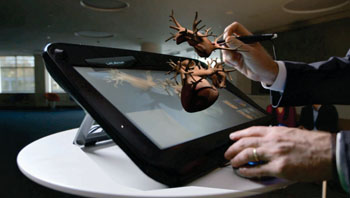Simulated Human Heart Advances Cardiology Studies
By HospiMedica International staff writers
Posted on 17 Jun 2015
An accurate three dimensional (3-D) model of the human heart could help accelerate device testing and research in the treatment of heart disease. Posted on 17 Jun 2015
The “Living Heart” model, powered by the Dassault Systèmes (3DS; Vélizy-Villacoublay, France) 3DEXPERIENCE platform, represents a baseline four-chamber healthy human heart, which can be used to study congenital defects or heart disease by modifying the shape and tissue properties in an easy-to-use software editor. In addition, medical devices can be virtually inserted into the simulator to study their influence on cardiac function, validate their efficacy, and predict reliability under a range of operating conditions.

Image: Manipulating the 3DS living heart simulator (Photo courtesy of Dassault Systèmes).
The high-fidelity, scientifically validated 3-D simulated cardiac model includes well-defined anatomic details of the heart as well as proximal vasculature, such as the aortic arch, pulmonary artery, and superior vena cava (SVC). The dynamic response of the heart model to virtual devices is governed by realistic electrical, structural, and fluid flow physics. For example, coronary stents can be evaluated for optimal type, size, and placement location to achieve the best performance.
The simulator was created as part of the “Living Heart Project”, which uses crowdsourcing to build its models, while protecting the intellectual property of each member. Some of the 45 members are the US Food and Drug Administration (FDA), the Medical Device Innovation Consortium (MDIC; St. Louis Park, MN, USA), and technology providers, cardiologists, and medical device manufacturers and hospitals, such as St. Jude Medical (SJM, St. Paul, MN, USA), and the Mayo Clinic.
“The availability of the first commercial, physics-based simulated heart marks a significant milestone for digital medical tools that will advance cardiovascular science and directly impact the quality of life of patients,” said Scott Berkey, CEO of SIMULIA at Dassault Systèmes. “The ‘Living Heart Project’ is proof that our technology can potentially change the course of therapies through simulation of the human body. We will continue to collaborate with the biomedical community and our partners to provide technology and applications that will enhance the experience for heart patients everywhere.”
“I had been aware of advances in simulation technology, but prior to the ‘Living Heart Project’ I was unaware that it could address the types of challenges I have as a practicing cardiologist and medical educator,” said Robert Schwengel, MD, of Brown University (Providence, RI, USA). “Having spent time with their 3-D experiences, I believe a product like this could be very powerful in helping to educate my patients, students of medicine, and current medical professionals, as well as lead to improved diagnostic capabilities and the personalization of medical therapeutics.”
Related Links:
Dassault Systèmes
Medical Device Innovation Consortium
St. Jude Medical














